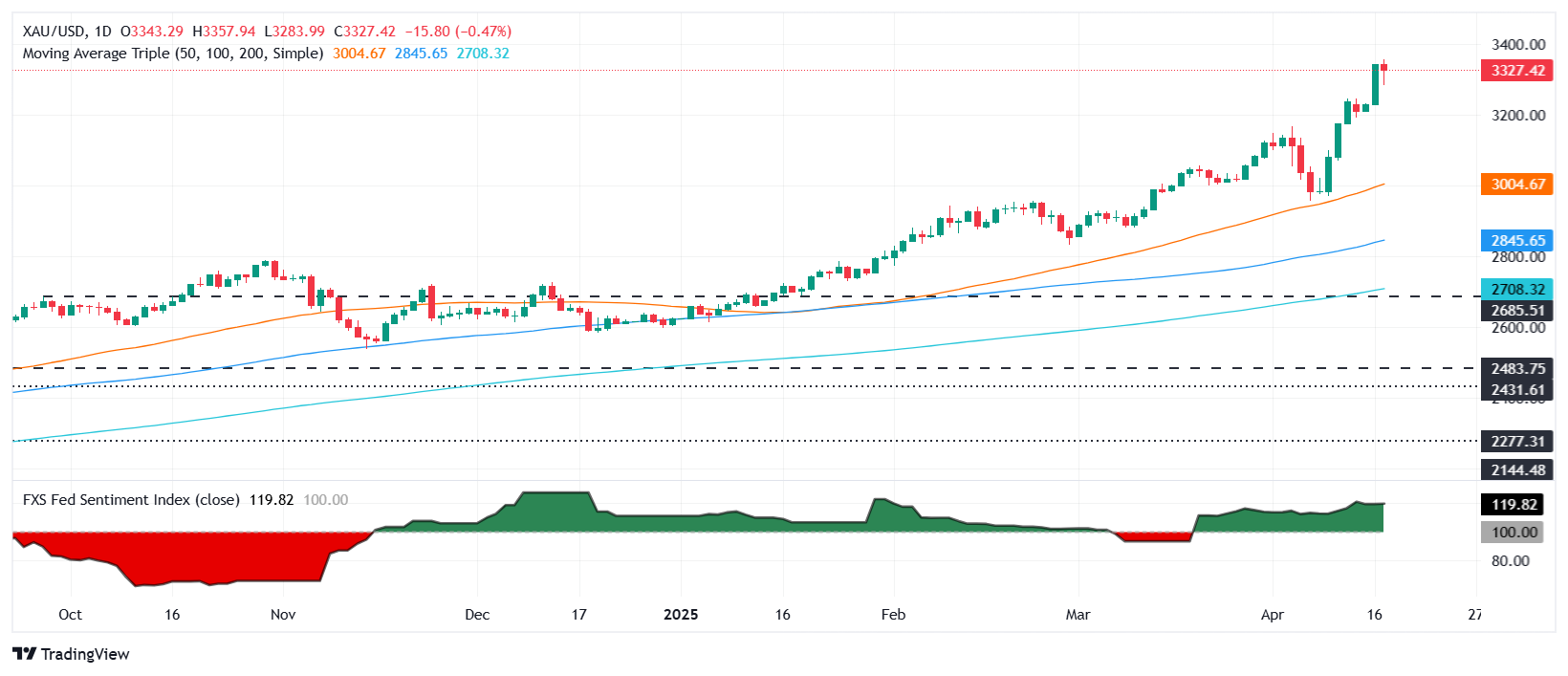- Gold goes back from the historical maximum of $ 3,357 while Powell warns that Fed’s objectives can conflict, increasing concerns about stagflation.
- Mixed market: The Dow low after the collapse of Unitedhealth while other indexes see modest profits.
- Trump points out advances in commerce with the EU and China; The ECB cuts 25 bp rates, expanding the divergence of global policies.
Gold backed on Thursday before Easter holidays, losing 0.60%, after enjoying a rally of about $ 400 in the last seven days of negotiation due to uncertainty about United States commercial policies (USA). The USD is quoted at $ 3,319 after reaching a historical maximum of 3,357 $ early in the session.
The mood of the market closed the last negotiation day of the mixed week, with two of the three main US indexes registering profits, while the collapse of UnitedHealth affected Dow Jones. Wednesday’s speech by the President of the Federal Reserve (FED), Jerome Powell, remains digested by the markets.
The president of the Fed, Powell, adopted a more aggressive tone, revealing that a weak economy and high inflation could conflict with the two objectives of the Central Bank, making possible a scenario of stagning.
“We could find ourselves on the challenging stage in which our dual mandate goals are in tension,” he said. “If that happened, we would consider how far the economy of each objective is, and the potentially different time horizons over which it would be anticipated that those respective gaps would close.”
As for commercial conversations, Trump said they are going well and added that he is very confident in a commercial agreement with the European Union (EU) and China.
In terms of data, the European Central Bank (ECB) reduced the rates in 25 early basic points and the US economic calendar revealed that the US labor market is still solid, but not the housing sector, after printing strong figures for construction permits, but weak in homes.
What moves the market today: the price of gold falls while US yields
- The 10 -year Treasury bonus yield from the US rises five basic points to 4,333%. The real US yet yields followed the same trend, uploading five PB to 2,163%, as shown by the yields of the treasure values against inflation to 10 years from the US that failed to contain gold prices.
- The initial applications of US unemployment subsidy for the week that ended on April 12 were 215K, coming down from 224k and below the 225K forecast, highlighting the continuous strength in the labor market.
- Construction permits increased 1.6% to 1,482 million, exceeding 1.45 million estimates. In contrast, the beginnings of housing fell dramatically from 1,494 million to 1,324 million, indicating weakness in residential construction.
- In rates markets, monetary market operators have incorporated 86 basic points of Fed fees cuts by the end of 2025, with the first expected cut in July.
Xau/USD technical perspectives: The price of gold goes back, but remains prepared to try new historical maximums
The upward trend in gold prices is maintained despite going back something on Thursday, below the figure of $ 3.330. As precious metals cut some of their previous losses, the price action indicates the lack of lower prices acceptance, opening the door to more increases.
From a point of view of Momentum, the relative force index (RSI) is in envelope but not close to the extreme level of 80. However, as the RSI points down, it suggests that a movement of reversion to the average is on its way. In case that happens, the first XAU/USD support would be the figure of $ 3,300. A rupture of this last will present the minimum daily of April 16, $ 3,229.
If the bundles push prices above $ 3,350, they could try the peak of the year to date (YTD), followed by $ 3,400.

FAQS GOLD
Gold has played a fundamental role in the history of mankind, since it has been widely used as a deposit of value and a half of exchange. At present, apart from its brightness and use for jewelry, precious metal is considered an active refuge, which means that it is considered a good investment in turbulent times. Gold is also considered a coverage against inflation and depreciation of currencies, since it does not depend on any specific issuer or government.
Central banks are the greatest gold holders. In their objective of supporting their currencies in turbulent times, central banks tend to diversify their reserves and buy gold to improve the perception of strength of the economy and currency. High gold reserves can be a source of trust for the solvency of a country. Central banks added 1,136 tons of gold worth 70,000 million to their reservations in 2022, according to data from the World Gold Council. It is the largest annual purchase since there are records. The central banks of emerging economies such as China, India and Türkiye are rapidly increasing their gold reserves.
Gold has a reverse correlation with the US dollar and US Treasury bonds, which are the main reserve and shelter assets. When the dollar depreciates, the price of gold tends to rise, which allows investors and central banks to diversify their assets in turbulent times. Gold is also inversely correlated with risk assets. A rebound in the stock market tends to weaken the price of gold, while mass sales in higher risk markets tend to favor precious metal.
The price of gold can move due to a wide range of factors. Geopolitical instability or fear of a deep recession can cause the price of gold to rise rapidly due to its condition of active refuge. As an asset without yield, the price of gold tends to rise when interest rates lower, while the money increases to the yellow metal. Even so, most movements depend on how the US dollar (USD) behaves, since the asset is quoted in dollars (Xau/USD). A strong dollar tends to keep the price of gold controlled, while a weakest dollar probably thrusts gold prices.
Source: Fx Street
I am Joshua Winder, a senior-level journalist and editor at World Stock Market. I specialize in covering news related to the stock market and economic trends. With more than 8 years of experience in this field, I have become an expert in financial reporting.







